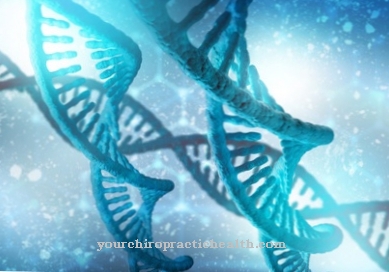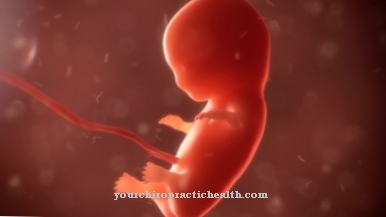The heart rhythm can be divided into two main phases, with systole Tension phase and ejection phase, and diastole, with the relaxation phase, can be divided. The tension phase is the beginning part of the systole, in which the two leaflet valves are closed passively, due to the increase in pressure, and also actively, due to muscle tension, and the two pocket valves to the aorta and pulmonary artery are initially still closed. When the pocket flaps are opened, the tension phase changes to the expulsion phase.
What is the tension phase?

The tension phase is a part of the heart rhythm phases, which can be divided into the two main phases systole and diastole. Systole is the contraction phase of the two chambers (heart ventricle) that takes place at the same time, during which the blood is pumped into the aorta (left chamber) and the pulmonary artery (right chamber).
The diastole is the phase of relaxation and filling of the ventricles, which coincides with the phase of contraction of the atrium (atrium).
The systole begins with the short tension phase, at the beginning of which the leaflet valves to the atria close passively by building up pressure in the chambers. The process is actively supported by muscular tension in the tendon threads at the edge of the leaflet valves. The pocket valves that close the aorta (left ventricle) and the pulmonary artery (right ventricle) are also still closed during the tension phase.
If the blood pressure exceeds the diastolic value in the arteries due to the contraction of the ventricular muscles (myocardium), the pocket flaps open automatically, as they work like a check valve. When the pocket flaps are opened, the tension phase changes to the ejection phase of systole.
Function & task
The tension phase marks the transition from diastole, the relaxation and filling phase of the ventricles, to the beginning systole, the tension and ejection phase of the chambers. During the tension phase, which only lasts around 50 to 60 milliseconds, the ventricular muscles contract and shorten accordingly.
Since all heart valves are closed during this phase, the tension of the heart muscle takes place under isovolumetric conditions, i.e. with constant blood volume in the chambers. This means that the ventricles assume an almost spherical shape during the tension phase, which facilitates the build-up of pressure and the subsequent ejection phase.
The tension phase is also important for controlling the heart valves. The two leaflet valves, the mitral and tricuspid valves, must close properly so that as little as possible of any blood that had flowed into the chambers immediately before is pushed back into the atria. The two leaflet flaps act as inlet valves for the chambers. At the same time, the two pocket valves, the pulmonary and aortic valves, remain closed so that no blood flows from the arteries back into the chambers as long as the pressure in the ventricles is lower than the diastolic pressure in the arteries.
The two pocket flaps act as outlet valves for the ventricles. If the blood pressure in the chambers exceeds the diastolic blood pressure, the two pocket flaps open automatically, so that the blood can be pumped into the main arteries if the chamber muscles continue to contract.
The transition from the tension to the expectoration phase with opening of the pulmonary and aortic valves is sensory, via baroreceptors that "measure" the blood pressure at certain points in the bloodstream, in the unconscious control of the cardiovascular system.
The beginning of the tension phase coincides with the first heartbeat that can be heard with the stethoscope. It is typically dull, i.e. low-frequency, and takes about 140 milliseconds. It is caused by the tension in the ventricular muscles and is not - as previously assumed - due to the closure of the two leaflet valves.
Illnesses & ailments
The tension phase of the heart is part of the systole and should be seen in connection with the other phases of the heart rhythm, since disturbances or problems with one of the phases in a closed circuit such as the blood circulation inevitably affect the other phases.
The tension phase can only function properly if all components involved function in the normal range. The heart can only take on a spherical shape during the tension phase, which is used to support the subsequent ejection phase, if the pressure is within the normal range.
If there is hypertension (high blood pressure), especially if the diastolic pressure in the arteries is permanently increased, the myocardium has to work harder during the tension phase so that the two pocket flaps open through which the blood has to pass during the ejection phase. The greater force that the myocardium has to exert leads to hypertrophy of the heart muscle in the long term, which has a negative effect on the performance and elasticity of the myocardium.
A relatively common dysfunction of the mitral valve leads, depending on the severity of the insufficiency, to an incipient return of blood from the left ventricle into the left atrium during the tension phase. This reduces the efficiency of the heartbeat performance, so that the heart has to compensate for the lack of performance by increasing the frequency and / or increasing blood pressure. In both cases, the heart tries to compensate for the higher demands placed on the myocardium by hypertrophication, which in this case also has the opposite effect. The hypertrophied heart muscle becomes inelastic and weaker in overall performance.
Insufficiency of the mitral or tricuspid valve can mean that the flow resistance that arises when the heart valves are closed and tight during the tension phase is too low for one or more leaky heart valves to allow the myocardium to form an approximately spherical shape.
Similar problems can arise in the case of cardiac arrhythmias that are relatively common, especially in the case of atrial fibrillation. The atria cannot contract properly, so that the degree of filling of the chambers during the tension phase does not correspond to the normal value, which the heart responds with hypertrophication of the heart muscle.
























.jpg)



